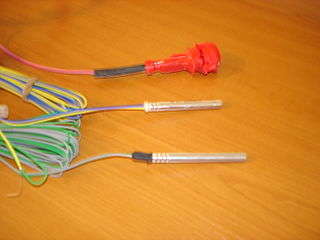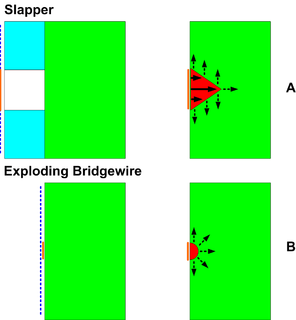
An explosive is a reactive substance that contains a great amount of potential energy that can produce an explosion if released suddenly, usually accompanied by the production of light, heat, sound, and pressure. An explosive charge is a measured quantity of explosive material, which may either be composed solely of one ingredient or be a mixture containing at least two substances.

Pentaerythritol tetranitrate (PETN), also known as PENT, PENTA, TEN, corpent, or penthrite, is an explosive material. It is the nitrate ester of pentaerythritol, and is structurally very similar to nitroglycerin. Penta refers to the five carbon atoms of the neopentane skeleton. PETN is a very powerful explosive material with a relative effectiveness factor of 1.66. When mixed with a plasticizer, PETN forms a plastic explosive. Along with RDX it is the main ingredient of Semtex.

A detonator, frequently a blasting cap, is a device used to trigger an explosive device. Detonators can be chemically, mechanically, or electrically initiated, the last two being the most common.

C-4 or Composition C-4 is a common variety of the plastic explosive family known as Composition C, which uses RDX as its explosive agent. C-4 is composed of explosives, plastic binder, plasticizer to make it malleable, and usually a marker or odorizing taggant chemical. C-4 has a texture similar to modelling clay and can be molded into any desired shape. C-4 is metastable and can be detonated only by the shock wave from a detonator or blasting cap.

ANFO ( AN-foh) (or AN/FO, for ammonium nitrate/fuel oil) is a widely used bulk industrial explosive. It consists of 94% porous prilled ammonium nitrate (NH4NO3) (AN), which acts as the oxidizing agent and absorbent for the fuel, and 6% number 2 fuel oil (FO). The use of ANFO originated in the 1950s.
An explosive booster is a sensitive explosive charge that acts as a bridge between a conventional detonator and a low-sensitivity explosive such as TNT. By itself, the initiating detonator would not deliver sufficient energy to set off the low-sensitivity charge. However, it detonates the primary charge, which then delivers an explosive shockwave that is sufficient to detonate the secondary, main, high-energy charge.

The exploding-bridgewire detonator is a type of detonator used to initiate the detonation reaction in explosive materials, similar to a blasting cap because it is fired using an electric current. EBWs use a different physical mechanism than blasting caps, using more electricity delivered much more rapidly, and explode in a much more precise timing after the electric current is applied, by the process of exploding wire method. This has led to their common use in nuclear weapons.

Detonating cord is a thin, flexible plastic tube usually filled with pentaerythritol tetranitrate. With the PETN exploding at a rate of approximately 6,400 m/s (21,000 ft/s), any common length of detonation cord appears to explode instantaneously. It is a high-speed fuse which explodes, rather than burns, and is suitable for detonating high explosives. The detonation velocity is sufficient to use it for synchronizing multiple charges to detonate almost simultaneously even if the charges are placed at different distances from the point of initiation. It is used to reliably and inexpensively chain together multiple explosive charges. Typical uses include mining, drilling, demolitions, and warfare.

A slapper detonator, also called exploding foil initiator (EFI), is a relatively recent kind of a detonator developed by Lawrence Livermore National Laboratory, US Patent No. 4,788,913. It is an improvement of the earlier exploding-bridgewire detonator; instead of directly coupling the shock wave from the exploding wire, the expanding plasma from an explosion of a metal foil drives another thin plastic or metal foil called a "flyer" or a "slapper" across a gap, and its high-velocity impact on the explosive then delivers the energy and shock needed to initiate a detonation. Normally all the slapper's kinetic energy is supplied only by the heating of the plasma by the current passing through it, though constructions with a "back strap" to further drive the plasma forward by magnetic field exist too. This assembly is quite efficient; up to 30% of the electrical energy can be converted to the slapper's kinetic energy.
Shock sensitivity is a comparative measure of the sensitivity to sudden compression of an explosive chemical compound. Determination of the shock sensitivity of a material intended for practical use is one important aspect of safety testing of explosives. A variety of tests and indices are in use, of which one of the more common is the Rotter Impact Test with results expressed as FoI At least four other impact tests are in common use, while various "gap tests" are used to measure sensitivity to blast shock.

A pyrotechnic fastener is a fastener, usually a nut or bolt, that incorporates a pyrotechnic charge that can be initiated remotely. One or more explosive charges embedded within the bolt are typically activated by an electric current, and the charge breaks the bolt into two or more pieces. The bolt is typically scored around its circumference at the point(s) where the severance should occur. Such bolts are often used in space applications to ensure separation between rocket stages, because they are lighter and much more reliable than mechanical latches.

A strong link/weak link and exclusion zone nuclear detonation mechanism is a type of safety mechanism employed in the arming and firing mechanisms of modern nuclear weapons.

Erythritol tetranitrate (ETN) is an explosive compound chemically similar to PETN, though it is thought to be slightly more sensitive to friction and impact.
In military munitions, a fuze is the part of the device that initiates function. In some applications, such as torpedoes, a fuze may be identified by function as the exploder. The relative complexity of even the earliest fuze designs can be seen in cutaway diagrams.
Explosive materials are produced in numerous physical forms for their use in mining, engineering, or military applications. The different physical forms and fabrication methods are grouped together in several use forms of explosives.
In explosives engineering, sensitivity refers to the degree to which an explosive can be initiated by impact, heat, or friction. Current in-use standard methods of mechanical senstivity determination differ by the sample preparation, sample arrangement, instrument type, go/not go criteria, and the statistical analysis of results.
A sympathetic detonation, also called flash over or secondary/secondaries (explosion), is a detonation, usually unintended, of an explosive charge by a nearby explosion.
A shock tube detonator is a non-electric explosive fuze or initiator in the form of small-diameter hollow plastic tubing used to transport an initiating signal to an explosive by means of a shock wave traveling the length of the tube. Shock tube is used to convey a detonation signal to a detonator. Shock tube is a hollow extruded tube containing a thin layer of energetic material upon its inner diameter. Once it is initiated, the shock tube transfers a signal to a detonating output charge.
A contact fuze, impact fuze, percussion fuze or direct-action (D.A.) fuze (UK) is the fuze that is placed in the nose of a bomb or shell so that it will detonate on contact with a hard surface.
Staged detonation is an overall principle used for many explosive devices. A general description of the principle is that one explosive compound with one set of properties is detonated, and the detonation wave from this is transfers into another explosive compound with different set of properties.










